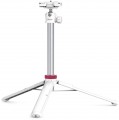Maximum height
The maximum height from the base on which the tripod base can be mounted.
For desktop use (see "Installation"), a large height is not required, therefore, in most of these models, this figure does not exceed 20 cm — the only exceptions are some specific monopods. Accordingly, the difference in height between different desktop structures in most cases does not matter much. But in the floor models, the most "undersized" have a maximum height of about 40 – 50 cm, and the highest ones are able to open up to 2.5 m and even higher. In such cases, the choice should take into account the specifics of use. So, it makes sense to specifically look for a model at
150 – 160 cm if it is fundamentally important to install the camera at eye level (eye level is usually about 10 cm lower than a person’s height). At the same time, most camcorders and many cameras have swivel screens that allow you to comfortably look at the device from top to bottom; and even in the absence of such a screen, bending down to the level of the camera is not so difficult. And it makes sense to pay attention to tripods with a height of
170 cm and above mainly in those cases when shooting over heads is planned — for example, reports from public events.
Leg sections
The number of individual sections that make up the legs of a tripod or monopod shaft (see "Type").
In desktop models (see "Installation"), the legs are often not divided into sections at all, for such cases this parameter is not indicated at all. In turn, almost all floor tripods have several sections, and the number of the latter with the same maximum height can be different. Here it is worth considering that more sections means a smaller size of each of them and more compact dimensions of the tripod when folded; and a smaller number — simplifies the design, increases its reliability and reduces cost.
The most popular options nowadays by the number of sections are 2 pcs,
3 pcs,
4 pcs,
5 pcs,
6 pcs,
8 pcs.
Support material
Support material — the lower part of the legs, in direct contact with the surface on which the tripod is placed.
—
Rubber. Rubber feet are perfect for hard surface applications. They securely stand on almost any material, do not slip and even tend to “stick” slightly, additionally holding the tripod in place. In addition, such supports do not damage delicate coatings such as parquet or polished wood, and they themselves, in turn, resist damage well, are not afraid of asphalt and other rough materials. For installation on the ground, viscous or loose material, rubber is somewhat worse than spikes, but this moment is rarely critical, and supports of this type are widespread in modern tripods.
—
Thorns. Supports in the form of rather sharp spikes are able to pierce into soft surfaces, securely fixing the entire structure on them. This option is perfect for installation on soft ground, sand or clay, hard snow, etc. At the same time, sharp spikes are not suitable for hard surfaces: they tend to slip and can damage soft materials. Therefore, in its pure form, this type of support is quite rare, more often a combination of spikes / rubber is used (see below).
—
Spikes / rubber. Supports in the form of spikes with removable rubber caps put on them. About both options separately, see above, and their combination makes the design as versatile as poss
...ible, allowing it to be adjusted to different types of surfaces. So, spikes are well suited for a lawn or beach, and if you need to move to the asphalt or go into a room, sharp supports can be covered with rubber caps. Due to this versatility, combo stands are very popular among floor tripods (see "Installation"), but it makes no sense to use them in tabletop models.
— Plastic. Supports, in many respects similar to the rubber ones described above; also designed for use mainly on hard surfaces, including delicate ones. One of the key advantages of plastic is its low cost. On the other hand, such supports are somewhat less reliable and durable than rubber ones, and are more prone to slip, which is why they are much less common.
— Magnetic. Supports with permanent magnets built into them, capable of “sticking” to magnetic surfaces and providing additional fixation reliability. They are used exclusively in table tripods, mostly flexible (see "Type") — it does not make sense to install such supports in a larger model. But in compact designs, the strength of the magnets can even be enough to hold a tripod suspended “upside down” along with the camera. On the other hand, it is quite rare to put tripods on metal, so this option has not received distribution.
— Wheels. Supports in the form of wheels, usually self-orienting (as in office chairs). They are rare, mainly in professional studio tripods for video filming: both the tripods themselves and the cameras mounted on them are quite massive, and it is easier to move the entire structure from place to place on wheels.
